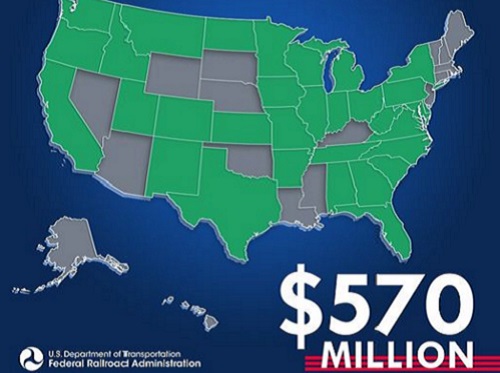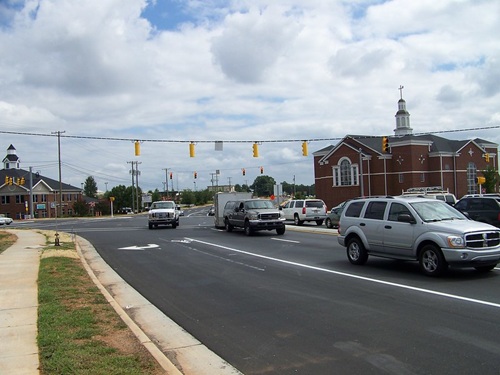The Federal Railroad Administration recently awarded more than $570 million in Railroad Crossing Elimination or RCE grants to 63 projects in 32 states; an inaugural round of funding that aims to improve safety at more than 400 at-grade crossings nationwide, as well as make it easier to get around railroad tracks by adding grade separations, closing at-grade crossings, and improving existing at-grade crossings where train tracks and roads intersect.
[Above image by the FRA]
FRA Administrator Amit Bose noted in a statement that, “for years,” the agency has received complaints from citizens, states, and localities regarding the delays and disruptions caused by frequently blocked crossings that force residents to wait hours at intersections or take detours – delays and disruptions that can also prevent first responders from getting to emergencies quickly.
Further, FRA noted that, in 2022, there were more than 2,000 highway-rail crossing collisions in the U.S. and more than 30,000 reports of blocked crossings submitted via the agency’s public complaint portal.
“The Railroad Crossing Elimination grant program is another critical tool that FRA is using to make a lasting impact on the safety and transportation needs of communities nationwide,” Bose added. “With these project selections and the many more that are to come, we will save lives and reshape infrastructure in ways that allow individuals to move through their neighborhoods seamlessly and safely.”
FRA noted that 22 percent of all the initial RCE grants, $127.5 million, went to projects in rural areas or on tribal lands. Along with projects that build or upgrade physical infrastructure at railroad crossings, the agency also awarded $15.7 million for planning activities and $33.1 million for project development and design activities that “build a pipeline of projects” for future funding as part of this initial tranche of RCE grant funding.
Several state departments of transportation were awarded grants by the FRA through this initial round of RCE program funding to address a variety of railroad crossing-focused projects. They include:
- The Colorado Department of Transportation will receive $700,000 to fund a comprehensive planning study to eliminate two at-grade highway-rail crossings on US 34. The agency identified the project area as the site of future freight investment needed in the Colorado Freight Plan – and the rights-of-way are owned by Union Pacific and Great Western Railway. The Colorado DOT is also providing a 22 percent non-federal match for this project, which qualifies for the statutory set-aside for planning projects.
- The Delaware Department of Transportation is getting $1.6 million for CSX railroad corridor safety improvements. This proposed planning project will conduct a feasibility study to eliminate the Centerville Road crossing in Elsmere, DE. This CSX crossing on its Philadelphia Subdivision averages 14 trains a day, plus 11 switching operations, as it is located next to CSX’s Wilmington Rail Yard. This crossing is frequently blocked, which presents a congestion and safety issue. Delaware DOT is providing a 20 percent non-federal match for this project, which qualifies for the statutory set-aside for planning projects.
- The Idaho Transportation Department is receiving $36 million for the SH-53 Pleasant View grade separation project. This proposed project will support right-of-way acquisition and construction of a highway interchange and highway-rail grade separation at the intersection of State Highway 53 and Pleasant Valley Road in Hauser, ID. Three existing highway-rail grade crossings will be closed along a two-mile segment of BNSF’s corridor. The Idaho Transportation Department, BNSF, and the Post Falls Highway District will contribute funds totaling a 20 percent non-federal match for this project, which qualifies for the statutory set-aside for projects in rural areas.
- The Maryland Transit Administration, a division of the Maryland Department of Transportation, is getting over $1.5 million for the Warner Street highway-rail grade crossing project. This proposed project will support planning activities and construction of minor safety improvements at an existing at-grade crossing as well as fund a long-term study to grade separate the crossing. The project will encompass grade separation alternatives analysis, feasibility, and concept design study as well as design and construction of short-term crossing improvements on CSX right-of-way. The Maryland DOT and the City of Baltimore are together providing a 20 percent non-federal match for this project. FRA added that $400,000 of this project funding amount qualifies for the statutory set-aside for planning projects.
- The Minnesota Department of Transportation’s Office of Freight and Commercial Vehicle Operations is receiving $480,000 for a planning study regarding the future of the “severely humped highway/BNSF rail grade crossings” for closure, consolidation, or improvements. This proposed planning project will support a corridor planning study to evaluate a 112-mile segment of BNSF’s Hinckley Subdivision, from the Minnesota/Wisconsin border to the Twin Cities area – a corridor that includes roughly 121 at-grade crossings, 96 of which are public. This subdivision has been identified as the selected alternative for the proposed Northern Lights Express corridor and Minnesota DOT’s study intends to evaluate each crossing for closing or safety improvement. Minnesota DOT is contributing a 20 percent non-federal match to this project, which qualifies for the statutory set-aside for planning projects and the statutory set-aside for projects in rural areas.
- The North Dakota Department of Transportation is getting $30 million for its 42nd Street grade separation Project to Improve Efficiency, Connectivity, Equity, and Safety, known as PIECES. This proposed project will support final design and construction of a grade separation and add a 10-foot shared-use path. Located near the University of North Dakota and residential areas, this project should reduce delays caused by the nearby Grand Forks Yard-associated train transfers. This project should also reduce 131 hours of vehicle delays and improve access to the local hospital, University of North Dakota campus, and more. North Dakota DOT, the BNSF railroad, and the City of Grand Forks will contribute a 38 percent non-federal match to this project, which includes $7.5 million in Federal Highway Administration funds.
- The New York State Department of Transportation is getting just over $11 million for the New York State Fairgrounds Crossing Consolidation Project, which will support final design and construction activities (installation of flashers, gates, traffic lights, and other safety devices) at the New York State Fair Grounds grade crossing on CSX right-of-way along State Fair Boulevard. The project is located at a state fairground that has high pedestrian traffic during roughly 200 annual events. The project will also provide access from the parking areas to the Fairgrounds and improve the crossing at a location which currently has only passive warning devices. NYSDOT will also contribute a 20 percent non-federal match to this project.
- The Pennsylvania Department of Transportation will receive $375,000 to fund a CSX/SEPTA Grade Crossing Elimination Study. That proposed planning project will initiate a crossing elimination study for three at-grade crossings on CSX/SEPTA lines that experience congestion and delays in the Philadelphia region. The three crossings are affected by a variety of factors, FRA noted: Meetinghouse Road sees delays due to loading at Twin Oaks Auto Distribution Yard along the CSX Princeton Line, while the Township Line and Woodbourne Road grade crossings are near the CSX Woodbourne Yard and experience CSX Trenton line and SEPTA West Trenton Line traffic. PennDOT is providing a 50 percent non-federal match for this project, which qualifies for the statutory set-aside for planning projects.
- The Texas Department of Transportation is receiving grants for two separate projects. The first, a US 90 Grade Separation Project, will receive $19.5 million, while the second – the Haslet-Fort Worth-Saginaw Corridor Bonds Ranch Road Grade Separation Project – will get over $17.1 million. The proposed US 90 Grade Separation Project closes the at-grade crossing along Waco Street and builds a grade separated bridge to eliminate the US 90 highway-rail crossing over existing Union Pacific railroad tracks. FRA noted it previously funded project development activities for these crossings under a 2019 CRISI grant. The agency added that this project includes Federal Highway Administration funds and TxDOT will contribute a 20 percent non-federal match to this project, which qualifies for the statutory set-aside for projects in rural areas. Meanwhile, the Haslet-Fort Worth-Saginaw Corridor Bonds Ranch Road Grade Separation Project aims to design and build a four-lane grade separated road, along with a new multimodal shared-use bicycle and pedestrian pathways, to improve safety and mobility options at the rail crossing right-of-way owned by BNS. This project also includes FHWA funds, with the City of Fort Worth and BNSF contributing 24 percent of the project’s cost in non-federal matching funds.
- The West Virginia Department of Transportation is getting $480,000 to implement a West Virginia Crossing Safety Action Plan; a plan that includes conducting a feasibility study on nine crossings on CSX and Norfolk Southern right-of-way throughout the state and provide a framework of strategies to improve safety, eliminate hazards, and reduce incidents. WVDOT is also providing a 20 percent non-federal matching funds for this project, which qualifies for the statutory set-aside for planning projects as well as the statutory set-aside for projects in rural areas.
FRA added that, over each of the next four years, it plans to make additional RCE program grants on an annual basis. Project selections for other grant programs that will improve freight rail safety and efficiency, strengthen supply chains, and expand the passenger rail network – representing billions of dollars in rail infrastructure – will be announced in the coming months, the agency added.
 Top Stories
Top Stories


